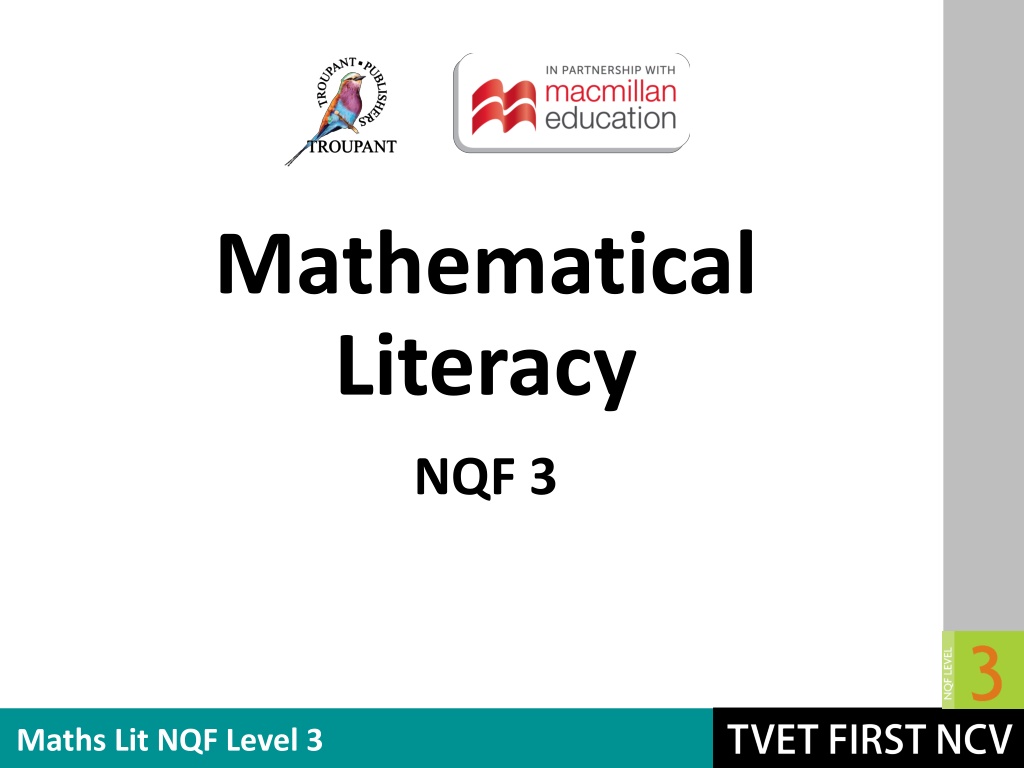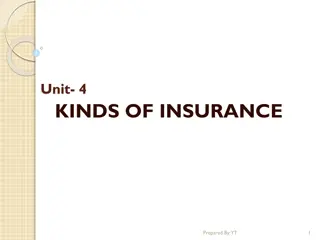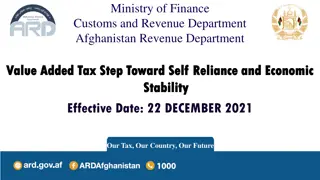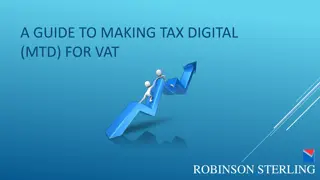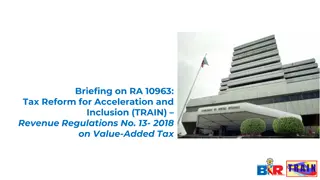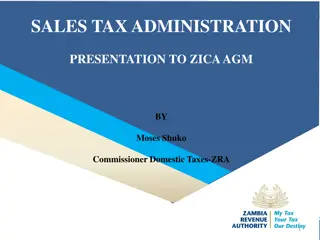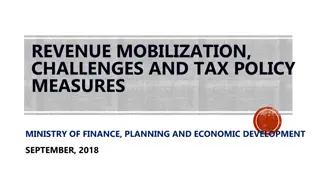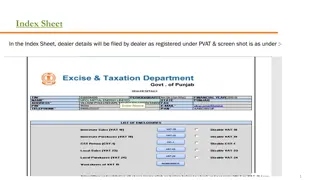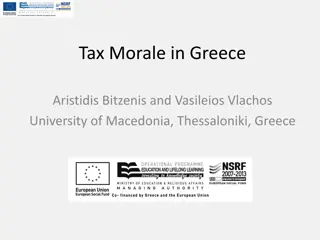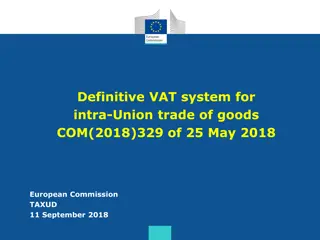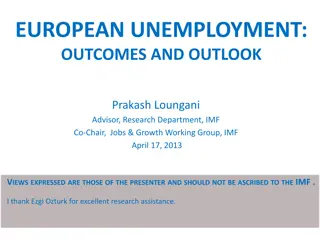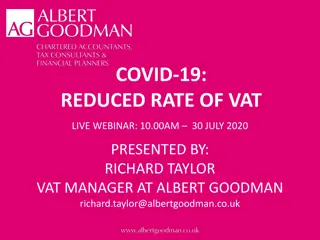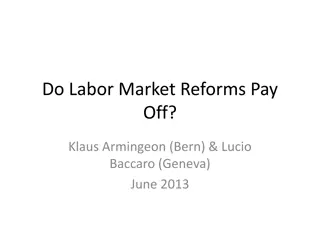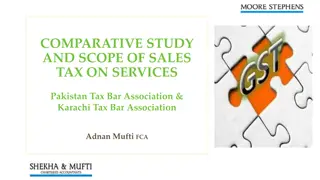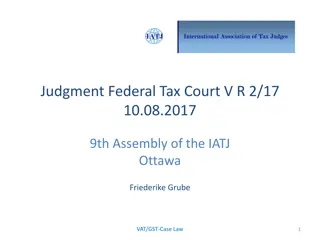Understanding Value Added Tax (VAT) and Unemployment Insurance in Mathematical Literacy NQF Level 3
Dive into the realm of Value Added Tax (VAT) in South Africa, distinguishing between VAT-inclusive and VAT-exclusive pricing, and exploring the Unemployment Insurance Fund. Learn how to calculate VAT on exclusive prices and decipher payslips to enhance your mathematical literacy skills at NQF Level 3.
Download Presentation

Please find below an Image/Link to download the presentation.
The content on the website is provided AS IS for your information and personal use only. It may not be sold, licensed, or shared on other websites without obtaining consent from the author. Download presentation by click this link. If you encounter any issues during the download, it is possible that the publisher has removed the file from their server.
E N D
Presentation Transcript
Mathematical Literacy NQF 3 Maths Lit NQF Level 3
Working with value added tax and unemployment insurance Module 10 Maths Lit NQF Level 3
Overview 10.1 VAT-inclusive versus VAT-exclusive 10.2 Understanding the Unemployment Insurance Fund 10.3 Reading and interpreting payslips Maths Lit NQF Level 3
VAT-inclusive versus VAT-exclusive Unit 10.1 VAT Value Added Tax Value Added Tax (VAT) in South Africa is charged on most goods and services at 14%. It is published annually by the Minister of Finance who has the power to change this rate at any time. VAT is collected by vendors (businesses) and paid over to SARS monthly. Some services and foodstuffs are exempt from VAT. Maths Lit NQF Level 3
VAT-inclusive versus VAT-exclusive Unit 10.1 Most prices advertised include VAT. The VAT payable has already been added to the price. VAT included Some prices advertised exclude VAT and the VAT is added to the advertised price. + VAT Maths Lit NQF Level 3
Calculating VAT on VAT-exclusive prices Unit 10.1 The price of a car is advertised as R359 950 without VAT. We can calculate the VAT: 14% R359 950 = R50 393 Add VAT to the advertised price: Total cost = R359 95 + R50 393 = R410 343 VAT on advertised price = 14% of price Maths Lit NQF Level 3
Example 10.1 page 202 Unit 10.1 Answer the questions relating to the quotation: Maths Lit NQF Level 3
Example 10.1 page 202 continued ... Unit 10.1 1. What is the price quoted to the customer for the service? 2. What does All prices exclude VAT mean? 3. How does it benefit Water Savers if they quote a price that excludes VAT? 4. a) Calculate the VAT to be charged on the service. b) Calculate the total cost to the customer. Maths Lit NQF Level 3
Example 10.1 page 202 continued ... Unit 10.1 1. R6 350,00 2. It means that the cost of VAT has not been added to the price. It has to be added to the final price given to the customer if he accepts the quote. 3. The price looks lower than it actually is. 4. a) 14% of R6 350 = R889,00 b) Price of service + VAT = R6 350 + R889 = R7 239 Maths Lit NQF Level 3
Calculating VAT on VAT-exclusive prices Unit 10.1 Determine the price before the VAT is added Method 1 Selling price is 100%. VAT is 14% R420,00 is 114% of selling price Method 2 R420,00 includes 14% VAT (100% of the cost of the goods) + (14% VAT on that cost) 420,00 114% = 368,42 R420,00 = 114% of cost of goods 100 114 Cost of goods = 420,00 Tax is calculated on R368,42: 14% of R368,42 = R51,58 = R368,42 14 VAT = 420,00 = R51,58 114 Breakdown of total charge: Cost of goods + VAT = R368,42 + R51,58 = R420,00 Maths Lit NQF Level 3
Example 10.2 page 203 Unit 10.1 Study the till slip below, then answer the questions that follow. 1. What did the customer pay for the goods? 2. a) Which items are exempt from VAT? Explain how you can identify them. b) What is the value of the goods that are exempt from VAT? Find the information on the till slip. 3. The value of the goods on which VAT was calculated, is R278,89. Show the calculations for this amount. 4. Show that the tax has been correctly calculated. Maths Lit NQF Level 3
Example 10.2 page 203 continued ... Unit 10.1 1. R376,41 2. a) Milk and eggs. They are marked with an asterisk (*). b) R58,48 3. Total amount VAT exempt items = R376,41 R58,48 = R317,93 R317,93 1,14 = R278,89 4. 14% of R278,89 = R39,04 Maths Lit NQF Level 3
Example 10.3 page 204 Unit 10.1 1. Calculate the VAT amount that has been left blank on the invoice: 2. Give 2 reasons why a business might find it useful to show the price before VAT and the VAT amount, on an invoice. Maths Lit NQF Level 3
Example 10.3 page 204 continued ... Unit 10.1 14 114 1. 4 845,00 = R595,00 2. A business would use the two amounts for business calculations: * the price before VAT to calculate their income * the VAT amount to calculate what to pay to SARS. Maths Lit NQF Level 3
Understanding the Unemployment Insurance Fund Unit 10.2 UIF Unemployment Insurance Fund 2% The Unemployment Insurance Act states that every employer should deduct 1% of basic salary from their employees. The employer should contribute another 1% of the employee s basic salary. This 2% is paid into the Unemployment Insurance Fund (UIF). Maths Lit NQF Level 3
Benefits of UIF to employees Unit 10.2 An employee is entitled to 1 day's pay for every 6 days worked to a maximum of 238 days. A claim can be made: 1 if the employee is retrenched 2 if the employee takes maternity leave 3 if the employee adopts a baby and takes leave 4 if the employee is terminally ill 5 if the employee dies and has dependents Maths Lit NQF Level 3
Employers' responsibilities Unit 10.2 The Unemployment Insurance Act is a law which states that: Every employerhas to register each employee for UIF. Maths Lit NQF Level 3
Example 10.4 page 207 Unit 10.2 Magdaline s payslip showed that her gross income for August 2017 was R13 345,00. 1. Calculate the amount her employer had to deduct for UIF payment. 2. Show that her employer submitted R266,90 to the fund. Maths Lit NQF Level 3
Example 10.4 page 207 continued ... Unit 10.2 1. 1% R13 345,00 = R133,45 2. The employer also had to contribute 1% of Magdalene s salary towards UIF. Employee s contribution + employer s contribution = R133,45 + R133,45 = R266,90 Maths Lit NQF Level 3
Reading and interpreting payslips Unit 10.3 Period of payment PAYE UIF All deductions Other possible deductions: Medical aid contribution Pension contribution Loan repayments Gross earnings Nett earnings Maths Lit NQF Level 3
Example 10.5 page 208 Unit 10.3 The payslip below shows what Andile Sibeko earned for the month of June 2018. Maths Lit NQF Level 3
Example 10.5 page 208 continued ... Unit 10.3 1. How much did Andile earn before deductions? 2. Check that the UIF calculation is accurate. 3. Check that the total deductions are correct. 4. How was Andile s nett pay calculated? Show the calculations. 5. How was Andile paid? Maths Lit NQF Level 3
Example 10.5 page 208 continued ... Unit 10.3 1. R7 375,00 2. 1% R7 375,00 = R73,75 3. R1 080,15 + R73,75 + R325,75 = R1 479,65 4. R7 375,00 R1 479,65 = R5 895,35 5. The money was paid into his Ithembekile cheque account. Maths Lit NQF Level 3
